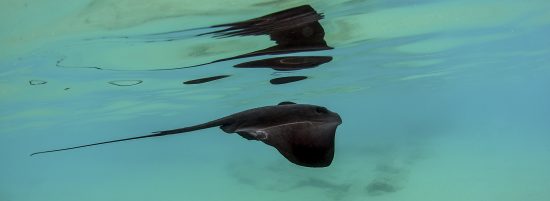



Eagle rays are a group of cartilaginous fish (fish that have skeletons made out of cartilage instead of bones), closely related to manta rays, sharks and skates.
You can differentiate an eagle ray from other rays by their triangular, wing-like pectoral fins. Combine that with a beak-like snout and you can see why they have been named after the majestic bird. Eagle rays prefer to roam the sandy bottom in search of prey, but are amazingly good swimmers and explore both the deep ocean floor (some have been recorded at 800m) and the ocean surface.
Eagle rays are the most agile of all rays thanks to their unique swimming style. If you only take a brief look at an unknown ray, you can tell it is an eagle if it flaps its fins up and down like a true eagle. Adding to the list of eagle resemblances, these magnificent fish often soar upwards and briefly jump out of the ocean to feed, play and communicate with other rays.
Unlike many other marine predators, these rays have flat plates rather than typical pointy teeth. They use a special organ in their snout to detect the electric fields of molluscs, crustaceans and other hard-shelled organisms that are hiding in the sand.
If an eagle ray were ever to develop a water-proof smartphone, they would likely use the spots on their back to unlock the screen, as the pattern is unique to each individual.
While sometimes found alone, eagle rays often swim in schools of several hundred.
Female eagle rays are much larger than their male counterparts. A possible reason behind this dimorphism is their reproductive strategy. They are ovoviviparous, meaning that the female eagle rays lay eggs then carry them until their young hatch and are ready to swim on their own.
If you are diving in the Mediterranean, there is a chance you will encounter the common eagle ray (Myliobatis aquila) like Ivana and Janez.
Besides being a spectacular sight, seeing these rays is unfortunately a rare blessing. The IUCN has declared their populations 'critically endangered' due to the pressures of overfishing.
Written by Lena Ilic B.Sc., Marine Biologist
Photos and video by Ivana OK and Janez Kranjc
 Ivana and Janez
Ivana and Janez 17th August 2022
17th August 2022